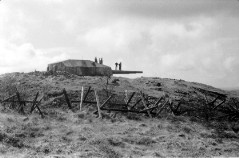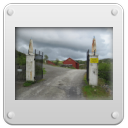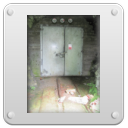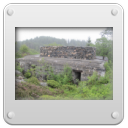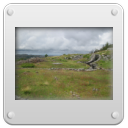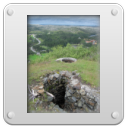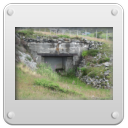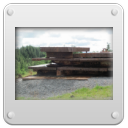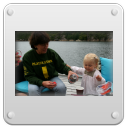Run #4 - Fjell Festning - 8 August 2010 - Bergen Bunker Hash House Harriers
Main menu:
Run #4 - Fjell Festning - 8 August 2010
Landlocked German naval guns
The run today
Welcome to Fjell festning and the 4th BBH3 run.
The run will take us through what is regarded by some, as one of the most complete and exciting coastal batteries within the entire Atlantic Wall. The fortress covers quite a large area (approx. 185 acres or 750 mål), however, the run will only cover part of this area and passes different types of bunkers, gun positions, tobruks and trenches. These will be described as we reach them.
First a very brief description of the construction of the main gun at Fjell festning which was given the designation MKB 11/504 Fjell:
The construction of the battery commenced in July/August 1942
A new deep water quay constructed in Tellnes
Roads between Tellnes and Fjell constructed or strengthened (local myth has it that it took 3 weeks to construct approx. 10 km of roads but realistically 3 months is probably more correct)
A crane in Bergen was dismantled and transported to Fjell where it was rebuilt
The gun emplacement including tunnels were built
The guns and turret were transported to Tellnes by boat
The turret and gun (approx. 1000 metric tonnes) was hauled up the mountain in December 1942
The guns were first tested on the 12th of July 1943
The main battery at Fjell was the B-
“Gneisenau” ended the war as a block ship and was sunk in Gothafen harbour on 23 March 1945. The original 28.3 cm guns were used in shore based batteries. Some guns from the A-
The main gun was never fired in anger.
The guns and turret were removed from Fjell in 1968 having been sold to a scrap merchant reputedly for NOK 3000. Parts of the armour plating from the turret are still to be seen outside the museum and are used to shore up the area around the museum.
Fjell festning was used as a coastal radar station by the Norwegian military until 2005.
On on
Sources
See the links page for the sources used for this page.
No |
Installations passed on the run |
Links to more pictures |
| Fl242 Flakeinheitstand für mittlere und leichte Flak |
||
B |
Ammunition tunnel (closed) |
|
C |
R638 Kleiner Sanitätsunterstand Between the two tunnel entrances is an R638 which is also locked and probably still used by Norwegian authorities. The bunker is a small field hospital. The trail passes another R638 which is open, and more information will be given then. |
|
D |
10.5 cm SKC/32 This gun is according to sources on the web, a 105 mm Flak gun. |
|
E |
This gun is according to sources on the web, an 88 mm Flak gun. According to the museum it is a 105 mm Flak gun. |
|
F |
Ammunition tunnel This is the second of a possible three ammunition or storage tunnels. One source suggests that this tunnel was used to store the ammunition for the Flak battery a few hundred metres down the road. Leading from the tunnel are rail tracks and in the forest opposite the tunnel are the remains of what probably were the rail tracks of the train used to haul the ammunition to the gun battery. The tunnel is closed and probably still used by the Norwegian military. |
|
G |
Vf storage under the road This Vf (Verstärkt feldmäßiger) storage facility has the road running right over it and consists of two storage rooms. One source suggests that Flak gun ammunition was stored here, something that seems plausible because the Flak guns are only a short distance from here. The remains of probably what used to be a lorry, is dumped behind this facility. Next to this facility is a structure which one source suggest is a bunker for horses, whilst another suggest a Pak garage. |
|
H |
R622 Doppelgruppenunterstand für 20 Mann This is a shelter for 20 people that's open and can be explored. The construction on top of the bunker is according to various sources, a radar emplacement. According to the museum at Fjell there were three radars at Fjell, a Würzburg D on this R622 and a Freya and Würzburg Riese Seetakt radar to the north of the fortress. Other sources suggest that the Freya was on this bunker. To the left of the bunker, is what one source describes as a generator room. |
|
I |
Flak Leitstand One source suggests that this building was a Flak Leitstand (control post). This seems logical because the building is situated in the middle of the six 10.5 cm Flak gun positions at Fjell. |
|
J |
10.5 cm Flak gun positions There are six Flak gun emplacements a few hundred metres south of the main gun. They are all open and of varying construction. According to some sources, they had the designation 5/802 "Batterie Buskevatn" and were part of Flakabt. 802 commanded by MAA 504 in Gravdal. Differing numbers of Flak guns at Fjell are listed on various web pages, one suggests 4 * 10.5 cm and 2 * 2 cm whilst another source suggests 6 * 10.5 cm and 4 * 2 cm. By counting the number of gun emplacements at Fjell, 6 * OB and 6 * Fl242, either there were fewer guns than emplacements or both sources are wrong. |
|
K |
R638 Kleiner Sanitätsunterstand This is the second of two small field hospitals. This one is open and can be explored. |
|
L |
This bunker is partly open, although perhaps the most interesting part is closed. In addition to the garage for a Pak, the bunker also had a crew room which has been sealed off, but part of the wall has been knocked down, and a staircase leading to an underground tunnel can be seen. This tunnel leads to an observation turret. One source gives it as type 486P2 while another gives it as type 749P3. This appears to be unique for this bunker and not part of a standard regelbau R629. A tunnel connected to the system of trenches to the west of the fortress also runs to and from this bunker. |
|
M |
Trenches There are quite a few trenches that were part of the close defence of Fjell. One source divides them into three groups: Infanterisicherung West, Infanterisicherung Süd and Infanterisicherung Ost. The most impressive of these three groups are the trenches to the west of the main gun, which run for hundreds of metres and connect three bunkers (R629, R621 and R633) and the fortified western entrance to the main tunnel system. The trenches also connect a number of 58c (MG positions) and 61a (grenade launchers). The trenches are mostly passable but in some places the walls have collapsed. |
|
N |
61a Ringstand für Granatwerfer There are a few 61a, also known as Bauform 206, at Fjell. All are connected to the trench system. The opening for the grenade thrower is lower than the surrounding ground so they are not visible until one is nearly on top of them. According to some sources the 5 cm grenade thrower used was of French origin. |
|
O |
58c Vf Ringstand The Ringstand 58c, also known as "Tobruk" or Bauform 201, was a concrete pillbox for a machine gun. There are quite a few at Fjell. Most are connected to the trench system, although a few are individually placed probably to defend other installations. |
|
P |
West entrance to the tunnels under the main gun The entrance is sealed and cannot be entered. Just to the north is an entrance to the main tunnel which was used to dump the stones excavated from the main tunnel. This entrance was sealed during World War II. |
|
Q |
R621 Gruppenunterstand für 10 Mann This fortified shelter is connected to the trench system and is open and can be entered. |
|
R |
35P8 Panzerturm mit 6 Scharten (2MG34) This MG turret is connected to the main tunnel and reached by way of steps leading up to a platform where the MG was mounted. The turret is 120 mm thick and weighs 18 tonnes. The machine guns used were MG-34. |
|
S |
S466 Leitstand für schwere Batterien This command bunker was one of the largest of the regelbau bunkers. The bunker housed a plotting and command post and a 10 metre range finder to measure the bearing and distance of targets. Two were built in Norway, one at Austrått fortress and one at Fjell, which both sported a gun turret form the Gneisenau. This S466 was at some point after 1945 modified to house a coastal radar and was used until 2005. One source suggests that a third S466 might have been built at Nøtterøy in Norway. The bunker and gun foundations were mentioned in documents from the spring of 1944. The battery was test fired during the war and became part of the Norwegian coastal artillery after the war, but is on what still is military ground and not open to the public and has never been confirmed to ever having been built. Only two more S466s are said to have been built, both in France, one in Corvee and one in Seydlitz. |
|
T |
North entrance to the tunnels under the main gun This bunker is the northern entrance to the main tunnel system running between the command post and the main gun. This is where the guided tours of the fortress exit the main tunnel. |
|
U |
R672 Pakgarage There are a few storage bunkers for Pak guns in the vicinity of the main entrance to tunnels in addition to two fortified positions for 4.7 cm Skoda Pak guns. |
|
V |
MG Sonderkonstruktion This construction is connected to the main tunnel system and housed a Pak gun which covered the area in front of the main entrance. It does not seem to be of any (known) regelbau type, and one source names it as "MG Sonderkonstruktion". |
|
W |
Main entrance to the tunnels under the main gun It also housed a 4.7 cm Skoda Pak gun to the left of the entrance. |
|
X |
Main gun The main gun was sold and removed from Fjell festning in 1968. Today a museum has been built to cover the shaft that housed the gun. Parts of the armour plating from the turret are still to be seen outside the museum and are used to shore up the area around the museum. The museum is open from May to August and offers guided tours through the underground part of the fortress. |




